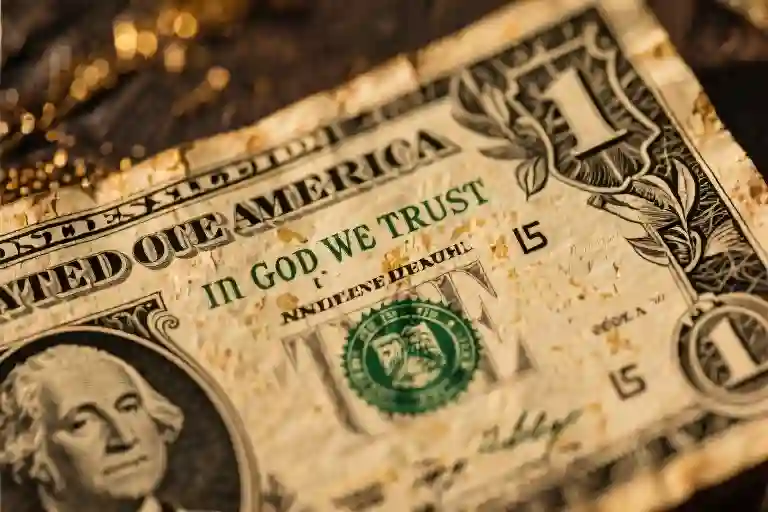The crisp green edge of a dollar bill catches the light as you pull it from your wallet. There, nestled between intricate engravings and serial numbers, four unassuming words whisper a nation’s complicated story: In God We Trust. This simple phrase, smaller than a postage stamp yet weightier than most constitutional amendments, has traveled from Civil War-era coins to modern courtroom battles, carrying with it the unresolved tensions between faith and governance in American life.
What begins as a mundane moment—checking cash for a coffee purchase—becomes a tactile encounter with history. The ink on that bill connects you to Salmon P. Chase’s 1864 decision during America’s bloodiest conflict, to Cold War legislators who weaponized the phrase against ‘godless communism,’ and to contemporary students who see those words etched above their classroom whiteboards with increasing unease.
This isn’t just about a motto. It’s about how nations choose their defining words, and how those words outlive their original intentions. Over the next sections, we’ll trace three intersecting paths: the historical accidents that elevated this phrase, the legal machinery that cemented its status, and the cultural forces that keep it relevant (or controversial) in an increasingly pluralistic society.
Notice how the paper currency feels slightly raised where the motto is printed—a physical reminder that symbols aren’t abstractions when they’re in your hands every day. That tangible presence explains why this debate matters: unlike forgotten legislative proclamations, In God We Trust enters pockets, vending machines, and tip jars with quiet persistence, making its message unavoidably personal.
From Civil War Coins to Cold War Slogans
The story of ‘In God We Trust’ begins not in the halls of Congress, but in the midst of a nation tearing itself apart. During the bloodiest year of the Civil War in 1864, Treasury Secretary Salmon P. Chase received a letter that would change American currency forever. A Pennsylvania minister had written suggesting that recognizing the Divine on our coins might help heal a fractured nation.
Chase, a devout Christian who famously inscribed ‘In God We Trust’ on his personal correspondence, needed little convincing. That same year, the phrase appeared on the new two-cent coin – the first U.S. currency to bear what would become our national motto. It wasn’t grand legislative action, but rather a quiet administrative decision that set this spiritual imprint on our monetary system.
The real transformation came nearly a century later during another period of national anxiety. In 1956, at the height of Cold War tensions, Congress passed a joint resolution declaring ‘In God We Trust’ the official national motto, replacing the Latin phrase ‘E Pluribus Unum’ that had served since the founding. The timing wasn’t coincidental – this was the era of adding ‘under God’ to the Pledge of Allegiance, when American identity became explicitly tied to religious faith as a bulwark against ‘godless communism.’
What began as a wartime spiritual comfort had become a Cold War ideological weapon. The numbers tell the story: where only about 20% of coins carried the motto in 1864, by 1956 it appeared on all currency – a 100% penetration into American wallets and purses. Chase’s original motivation, expressed in his instruction to the mint director that ‘no nation can be strong except in the strength of God,’ had evolved into something far more politically charged.
This historical journey from Civil War piety to Cold War propaganda reveals how national symbols accumulate meanings far beyond their creators’ intentions. The same phrase that once comforted a divided nation would later become a rallying cry in America’s culture wars – but that’s a story for another chapter.
The Legal Battleground: How Four Words Became Law
That phrase in your pocket change didn’t just appear by accident. The journey of “In God We Trust” from coin inscription to codified national motto reads like a legal thriller, complete with Cold War paranoia, courtroom showdowns, and ideological warfare. What began as a Civil War-era nod to divine providence would eventually require an act of Congress and survive multiple constitutional challenges.
The 1956 Act That Changed Everything
Picture the political climate when President Eisenhower signed H.J. Res. 396 into law on July 30, 1956. The McCarthy hearings had recently concluded, the phrase “under God” had been added to the Pledge of Allegiance just two years prior, and America was engaged in a global ideological struggle against “godless communism.” The bill passed with overwhelming bipartisan support – 82% of Congress voted affirmatively – reflecting less about religious fervor than about national identity politics. The legislative record shows fascinating debate snippets, like Representative Charles Bennett’s argument that the motto would “serve as a constant reminder” during the Cold War. What few realized was how this symbolic gesture would create legal headaches for generations.
When the Courts Got Involved
The first major legal test came in 1970’s Aronow v. United States, where the Ninth Circuit Court crafted what would become a lasting judicial framework. Facing arguments that the motto violated the Establishment Clause, judges invoked the concept of “ceremonial deism” – the idea that some religious references become so embedded in national tradition that they lose theological significance. The court’s reasoning compared “In God We Trust” to ceremonial phrases like “God save the United States and this honorable Court” that open Supreme Court sessions. This precedent would shield the motto for decades, though not without creating intellectual contortions. As one law professor later quipped, “We’ve essentially ruled that the more you violate the Constitution, the more constitutional it becomes.”
The Modern Legal Challenges
Fast forward to 2015, when new atheist organizations armed with fresh legal theories launched another assault. The Freedom From Religion Foundation’s case attempted to circumvent the ceremonial deism argument by focusing on the motto’s ubiquity and compulsory nature in public life. Though ultimately unsuccessful, these challenges revealed shifting judicial attitudes. The 2022 Kennedy v. Bremerton decision, which expanded allowances for religious expression in public spaces, unexpectedly breathed new life into motto defenders’ arguments. Legal scholars now debate whether the original ceremonial deism framework can survive current interpretations of the Establishment Clause.
What emerges from this legal history isn’t just a story about four words, but about how nations codify identity. The same phrase that once united Americans against external threats now divides them in internal debates about pluralism. As you fish that quarter from your pocket, remember: that tiny engrave represents a compromise forged in courtrooms as much as in the halls of Congress.
Cultural Icon: From Pocket Change to Football Fields
That familiar phrase tucked in the corner of every dollar bill does more than decorate currency—it pulses through the rhythms of American life in ways most of us rarely pause to consider. Three out of four Americans encounter these four words at least weekly, whether fishing for quarters at a laundromat or receiving change from a coffee shop cashier. The ubiquity matters precisely because we’ve stopped seeing it; like the hum of refrigerator motors or the taste of tap water, “In God We Trust” has become part of our sensory background noise.
Florida’s state capitol building engraves the motto above its legislative chambers, but you’ll find it equally at home on the helmets of high school football players in Texas. Before Friday night games, teams gather in end zones where the phrase often appears painted in school colors, helmets bowed during its recitation. This cultural duality fascinates—the same words that spark Supreme Court briefings also adorn Little League uniforms and PTA meeting agendas.
Linguists note how the pronoun “we” operates as both invitation and exclusion. When a Buddhist grocery clerk handles cash bearing the phrase or a Muslim student hears it recited before pep rallies, that collective “we” stretches uncomfortably. The Johnson family in Minneapolis keeps a jar by their front door labeled “In God We Trust” for loose change, while their atheist neighbors deliberately use credit cards to avoid handling what they call “compulsory piety.”
School boards from Vermont to Arizona have faced heated debates over classroom displays. Proponents argue the motto represents historical tradition, while opponents counter that public schools shouldn’t endorse theological statements. A middle school social studies teacher in Ohio told me she uses the phrase as a teaching moment: “We analyze it alongside the Treaty of Tripoli from 1797 that says America isn’t founded on Christianity. The cognitive dissonance makes for great classroom discussions.”
What emerges isn’t some monolithic cultural symbol but a mosaic of interpretations. For some, it’s a harmless historical artifact; for others, a profound declaration of values; and for still others, an institutional overreach. The tension lies in its simultaneous roles as national motto, spiritual declaration, and cultural shorthand—a rare phrase that manages to be wallpaper and lightning rod all at once.
The Battle Over Four Words
The phrase In God We Trust might occupy less than a square inch on a dollar bill, but the cultural space it claims in American life is vast and fiercely contested. What some see as a harmless historical tradition, others view as a constitutional violation. What believers cherish as a national affirmation of faith, atheists reject as governmental endorsement of religion. This tension has turned courtrooms into modern battlegrounds for interpreting four simple words.
When Lawsuits Become Prayer Books
In 2019, the Freedom From Religion Foundation (FFRF) filed yet another lawsuit seeking to remove the national motto from U.S. currency and government buildings. Their argument rested on familiar ground: the phrase violates the Establishment Clause by privileging monotheistic beliefs. The complaint cited psychological studies showing how state-sponsored religious messages alienate nonbelievers. One plaintiff, a secular schoolteacher, described the discomfort of handling cash bearing words that excluded her worldview during classroom transactions.
Opposing them stood a coalition of conservative legal groups armed with precedents like Aronow v. United States (1970), where the Ninth Circuit deemed the motto ‘ceremonial deism’ – more historical artifact than religious proclamation. Their briefs emphasized tradition over theology, arguing the phrase had lost any substantive religious meaning through decades of ubiquitous use.
Culture Wars in Twelve-Point Font
For many evangelical leaders, these legal challenges aren’t just about four words but a broader erosion of Christian influence. When a 2021 bill proposed removing In God We Trust from Georgia’s state buildings, Pastor Robert Jeffress called it ‘spiritual warfare,’ framing the motto as the thin line between America’s Christian heritage and secular oblivion. Megachurches launched ‘In God We Trust’ awareness campaigns, distributing car decals mimicking the currency design.
Yet Pew Research’s 2023 data reveals a nation divided: while 54% of Americans oppose removing the motto, support for retention drops to 28% among the religiously unaffiliated. The generational split is starker – 73% of Silent Generation respondents favored keeping the phrase versus 41% of Millennials. These numbers hint at an uncomfortable reality; the very ‘we’ in ‘We Trust’ may be fracturing along demographic lines.
The Weight of a Word
Beneath the legal and political clashes lies a simpler human truth: words gain power from who feels included in them. A Jewish veteran might see the motto as nonsectarian patriotism. A Muslim cashier could interpret it as Christian majoritarianism. An atheist senator may view it as an anachronism.
Perhaps the most telling development came in 2022, when the Supreme Court’s Kennedy v. Bremerton decision signaled greater tolerance for government-affiliated religious expression. Lower courts have since cited it when dismissing motto challenges, suggesting this particular battle – if not the wider war – may be reaching its legal conclusion. Yet as long as dollar bills change hands, the debate over whose trust they invoke will persist in schools, legislatures, and dinner tables across the country.
Global Reflections: National Mottos Without Divine Reference
The American motto “In God We Trust” stands in stark contrast to many national slogans that deliberately avoid religious connotations. France’s “Liberté, Égalité, Fraternité” embodies Enlightenment ideals without theological underpinnings, while India’s “Satyameva Jayate” (Truth Alone Triumphs) draws from ancient Sanskrit texts while maintaining pluralistic neutrality.
Across twenty major democracies, only six incorporate explicit religious references in their official mottos. Scandinavian countries like Sweden have no constitutional motto at all, while Canada’s “A Mari Usque Ad Mare” (From Sea to Sea) quotes Psalms but avoids direct deity invocation. This global mosaic reveals how nations negotiate identity through language – some anchoring in tradition, others embracing secular modernity.
The procedural differences in motto adoption prove equally revealing. Parliamentary systems like Britain require no legislative action to change royal mottos (“Dieu et mon droit” remains by monarchical prerogative), whereas Germany’s constitutional court could theoretically strike down any religious state symbol. When Australia debated replacing “Advance Australia” in 1999, the proposal failed not over content but through required referendum procedures – demonstrating how governance structures shape symbolic landscapes.
These international examples don’t resolve America’s motto debate, but they reframe it. The question becomes not whether “In God We Trust” should exist, but whether a nation’s symbolic language must remain static while its people evolve. As classrooms become more diverse and wallets go digital, the physical ubiquity of this phrase may diminish while its cultural weight persists – a paradox many nations have navigated through deliberate, if gradual, reinvention of their unifying words.
The Future of a Nation’s Motto
The words “In God We Trust” have weathered Civil War coinage, Cold War legislation, and countless courtroom battles. Now they face their most unpredictable challenge yet—the evolving identity of a nation that grows more diverse with each passing year. Three paths emerge from the historical and legal tapestry we’ve examined.
Option One: Preservation
Maintaining the status quo would honor nearly 160 years of tradition, from Salmon P. Chase’s 1864 coinage initiative to the 1956 congressional vote. Proponents argue this preserves historical continuity—the same reasoning behind the 1970 Aronow v. U.S. “ceremonial deism” ruling. Yet even this path isn’t static. Recent Supreme Court decisions like Kennedy v. Bremerton suggest shifting interpretations of religious expression in public life.
Option Two: Reversion
Some scholars propose returning to the original de facto motto, “E Pluribus Unum” (Out of Many, One). This Latin phrase adorned early U.S. currency and better reflects contemporary demographics. A 2023 Pew Research study found 33% of Americans support this change, particularly among younger generations. The practical hurdles? Congressional action would be required to amend the 1956 statute, a political minefield in polarized times.
Option Three: Expansion
A compromise approach might add a second, secular motto—a solution Canada adopted with its bilingual “A Mari Usque Ad Mare” (From Sea to Sea) and “God Keep Our Land.” This acknowledges both religious heritage and modern pluralism. France’s “Liberté, Égalité, Fraternité” demonstrates how secular values can unify diverse populations.
As you finish reading this sentence, somewhere in America:
- A teacher points to classroom lettering during civics class
- A cashier hands change bearing the contested phrase
- A federal judge reviews the latest First Amendment challenge
The true test lies not in legal arguments but in answering: Who gets to define “we” in a nation where 29% now identify as religiously unaffiliated? Perhaps the next chapter of this story won’t be written in courtrooms or Congress, but in everyday moments where citizens negotiate shared identity.
Where do you stand? The conversation continues—not just among scholars and politicians, but in school board meetings, coffee shops, and yes, even the comments section below.



